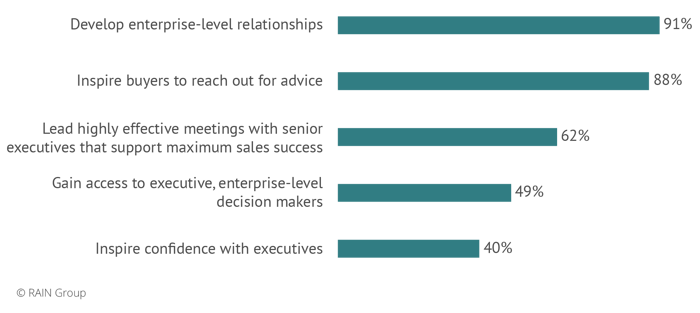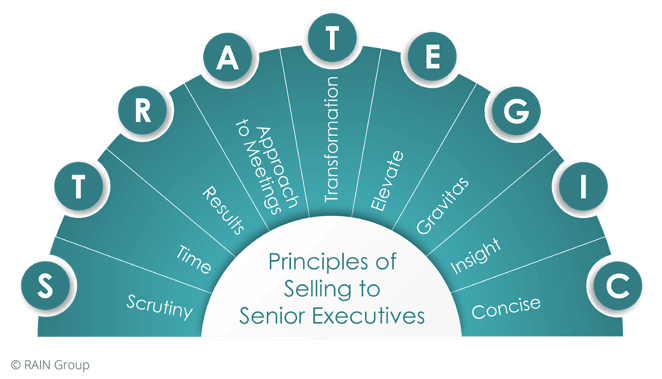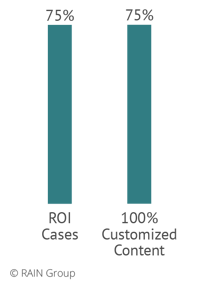TL;DR? Download the complimentary white paper and browse later.
In complex sales, professionals are facing a set of evolving challenges that impact the effectiveness and efficiency of their sales processes. Our research at RAIN Group has identified key trends that are shaping the sales landscape, notably:
- 43% of sales leaders have reported an increase in the length of sales cycles.
- 85% are encountering challenges due to an increase in the number of decision makers involved in each deal.
Against this backdrop is the increased involvement and evolving role of senior-level executives in the decision-making process for key purchases. Insights from business analysts suggest this trend is driven by the complexity of purchasing decisions, a strategic approach to purchasing, and the importance of cross-functional collaboration to increase the likelihood of implementation success. Senior executives’ engagement is crucial as it ensures that purchasing decisions are aligned with the organization's strategic goals and that there is consensus among all relevant stakeholders.
Frequently, senior executives, ranging from vice presidents to CEOs, become involved in key purchase decisions early on to understand how the proposed purchase relates to current business issues and to set the overall project strategy. It’s not unusual to see this across sectors.
One area where this is commonly experienced is with technology purchases. For example, not only are most software buyers making purchase decisions as a team (83%), but research from Gartner shows that buying teams are dominated by roles including C-level executives (36%) and president and CEO (30%). Senior-level involvement typically diminishes as projects move into the evaluation phase, where decisions are delegated to others. However, they may reengage later in the process during implementation planning or results measurement.
The involvement of senior-level executives in buying decisions, particularly in the context of complex business solutions, has become more pronounced, making it more important than ever that sales professionals are confident in their abilities to engage with senior executive buyers.
Selling to senior executives requires a nuanced approach; it embodies core consultative selling but goes well beyond that. Sellers in this environment need confidence in their abilities to understand the priorities of these executives and present solutions in a way that aligns with strategic objectives.
In this article, we explore how sales professionals can effectively engage with senior executives. We introduce the nine principles critical to this endeavor, highlight the differences in selling to senior executives compared to other buyers, and discuss the mindset required for sales professionals to succeed in this environment.
Our objective is to provide sales leaders with insights and a framework to gauge their teams’ readiness when it comes to selling to senior executive buyers.
A Framework for Executive Sales
Seller Confidence Engaging with Senior Executives
Think of a seller you know who:
- Has key relationships with influential executives and referral sources
- Regularly has rich and deep conversations with their key relationships
- Gets people to take actions and pursue priorities that are most helpful to them
These sellers are known for their relationship-building skills. They’re great with people both during the selling process and, often for the most successful sellers, outside of the sales process.
Our research indicates that, compared to others, Top-Performing Sellers are more successful and influential when interacting with key people, including when these people are in C-level and senior executive roles.
Top-Performing Sellers Are More Likely to...
% More Likely than The Rest

They understand the mindset, concerns, and strategic agendas of senior executives, allowing them to position value successfully.
They’re better able to win sales by developing the strongest relationships with these senior executives, who often play a buying role we call the Domino. The Domino is the person that, if they say, “Let’s do this,” everyone else will line up behind the purchase. The Domino may have only brief or tangential involvement, but if you get their ear and they want something, sales often move quickly.
In the remainder of this article, we share the nine principles that underpin successful selling to senior executives, why selling to them is different, and the mindset your sellers need to sell to them successfully.
9 Principles of Selling to Senior Executives: The STRATEGIC Framework
Selling to senior executives is different from selling to buyers at other levels of an organization. Of course, selling fundamentals remain constant: sellers need to discover needs, listen, craft compelling solutions, build and present the value case, and overcome objections. They need to plan and prepare for various meetings across the sales cycle.
All of these are table stakes for successful selling.
We're going to assume that these table stakes have been met and that the nuts and bolts of how to run different types of meetings are generally in place.
We focus here on how the dynamics of any meeting or interaction change when senior executives are involved and what sellers commonly need to do differently to succeed.
Our discussions and examples center primarily on early sales meetings with senior executives, such as discovering needs or driving ideas that can fill the pipeline, as these meetings tend to set the tone for the rest of the sales cycle.

When it comes to selling to senior executives, it’s critical that, in addition to core consultative selling skills, sellers master these nine interconnected principles:
- Scrutiny
- Time
- Results
- Approach to Meetings
- Transformation
- Elevate
- Gravitas
- Insight
- Concise
Or STRATEGIC, for short.
1. Scrutiny
Senior executives are highly discerning when it comes to evaluating potential business partners and vendors. They scrutinize everything from the seller to the company’s reputation, the details of your solution, the defensibility of the value case, and the way the seller communicates. They ask tough questions and expect sellers to be armed with answers.
To gain a senior executive’s trust, sellers and their work must be well-researched, logical and organized, and tailored to the executive’s specific needs and challenges.
2. Time
Everyone thinks they’re busy. However, senior executives are notoriously busy. They value and protect their time and expect sellers to do the same.
Gaining and maintaining a spot on a senior executive’s calendar requires that sellers use their time judiciously. A second chance to get more executive time after an unimpressive first meeting is unlikely.
3. Results
Senior executives care deeply about results. They typically expect ROI cases to be specific and reasonable, have a higher bar for the impact they need to achieve, and give more intense scrutiny to ROI cases and potential risks that could derail success.
While ROI case studies from other customers will help you tell the potential ROI story, they’re often not sufficient for winning the attention, confidence, or business of a senior executive. Bring something generic, especially later in the sales process when the seller should have greater access and more information to make a specific case, or something that falls apart under close executive inspection, and your opportunity may stall.
Which Content Influences C-Level and VP Buyers?
When selling to the executive suite, focus on content 100% customized to their specific situation and financial justifications with strong return on investment (ROI) cases.
C-Level and VP Buyers Influenced to Take a Meeting
% Strongly Agree

4. Approach to Meetings
When meeting with a senior executive, sellers should expect to get less time than they would with other buyers, so their interaction needs to be focused and strategic.
Yes, sellers benefit from having an agenda, being prepared, and being ready as in any sales meeting, but senior executives expect sellers to go the extra mile. And even absent that expectation, if the competition is more motivated to put in additional effort to impress an executive, the effect will be to marginalize the seller in the executive’s mind.
It’s contingent on sellers, then, to know what that extra mile might be and how to travel it well.
5. Transformation
Senior executives are often focused on driving transformation within their organizations. Sellers who become essential to that transformation win more.
This means:
- Knowing what priorities executives are working to drive
- Knowing how the seller, your company, and your offerings can be a part of the transformation
- Being able to tell the executive’s transformation story and how your product or service helps drive it better than your competitors
Imagine two sellers working with the same executive.
One says, “Here’s a published case study on how our offering has helped a competitor of yours achieve a similar transformation.”
This is where many sellers stop.
The second seller says, “Here’s a case study about a similar transformation at one of your competitors, but I’d like to focus our discussion on a plan we’ve built for how we’re going to help you, specifically, achieve your transformation, including what we’ve learned about you, what we propose to do, why we believe it’ll work, what it will cost, how long it should take, and the risks and challenges to avoid.”
If you were the senior executive, which of these sellers would you be inclined to give your time and focus to?
6. Elevate
Not only do senior executives have different—and higher!—expectations, but your competitors are also going to bring their A-game when they have opportunities with senior executives.
Sellers must elevate their approach across the board, often just to keep up, which includes:
- Speaking the executive’s language
- Understanding their strategic priorities
- Demonstrating your expertise in solving complex business challenges
- Outselling your competition
Selling to senior executives requires a different mindset to elevate sellers' approach.
7. Gravitas
“Should I listen to them or not?” “Do they know what they are doing or not?” “Are they sharp?” “Can I learn something from them?”
Senior executives will make assessments of sellers from the beginning. In that assessment, sellers want to be trusted and respected, seen as worthy of a seat at the table, taken seriously, and have their insights valued.
To command that respect, as senior executives do, sellers must project gravitas as an authority figure in their own right, both in style and substance.
8. Insight
To capture and hold the attention of senior executives, sellers must provide valuable insights. They need to inspire senior executives with ideas that matter and understand how to influence and change buyer thinking in critical areas.
Insights can come from a broad range of areas, including:
- The market
- The buyer's company
- The priorities that are most important
- What challenges to solve
- How to solve challenges in new and novel ways
Regardless of the form of insight, executives need to make decisions that drive success. To the extent a seller’s input can help them do that, executives will value time and interactions with them.
9. Concise
One of the most critical principles when selling to senior executives is being concise. Generally, sellers will succeed more if they’re concise and clear with all buyers, but the need is most pronounced with senior executives.
Indeed, everyone has their own personal interaction preferences. Some executives may be more to the point and all business, and some may be more personal and relationship oriented. Regardless of their personal interaction preferences, tolerance for meandering and disorganization is limited. Clarity and brevity are key.
Selling to senior executives is an art that requires finesse, strategy, and continuous learning. By internalizing the STRATEGIC model, sellers go beyond selling to strategically navigate the landscape of executive-level engagement.
Selling to Senior Executives Requires a Different Approach
I’d like to share a fictitious story about Jeremy, a seller at Perry Williamson, who had succeeded for years in selling to various buyers. Jeremy’s consultative selling and influencing skills, and his product knowledge, were strong, and he was used to navigating complex sales processes.
Jeremy set a meeting with Dana, a senior executive several levels above the buyers he typically sells to, at a Fortune 500 company for an opportunity seven times the size of what he typically sells. This company was a current customer of Perry Williamson’s, and a meeting with Dana, if successful, could lead to a great opportunity for Perry Williamson to expand its work across divisions and geographies.
He began the meeting with his typical conversational approach, one that had worked successfully with many other buyers. He asked questions to engage Dana in conversation and he came armed with relevant anecdotes and success stories.
But it quickly became apparent that selling to Dana was not like selling to other buyers. Jeremy started asking questions and talking, but Dana quickly diverted to different topics. Dana asked pointedly about integration and scalability, and what her competitors were doing at an enterprise level versus at the division level. Jeremy said he would have to get back to Dana on that.
Dana cut straight to the bottom line and asked what Jeremy thought the ROI might be if the company expanded their work with Perry Williamson. Jeremy responded confidently that ROI was typically greater than five times the investment and he had case studies to support this.
But then Dana said, “No. Specifically here. You work with us already. What do you believe it will be? And how fast?” Again, Jeremy said he’d have to get back to Dana.
Dana went on to ask how implementing Perry Williamson’s offering might help them achieve the company’s strategic objectives. When Jeremy answered, he could tell from Dana’s expression that he didn’t hit the mark.
And, finally, Dana asked what mistakes other executives make when implementing Perry Williamson’s solutions on a broad scale and what Dana should consider doing differently. Jeremy answered, but he could sense Dana knew he was improvising.
Jeremy was unprepared for this level of scrutiny and assertiveness.
After about 20 minutes, Dana told Jeremy that was all the time they had, and the meeting ended. Jeremy thought, “That was quick,” and suggested a follow-up meeting, but he didn’t have a good feeling that Dana was keen to continue.
Had Jeremy understood how selling to Dana might be different from his other buyers, he would have had a better chance of success.
Jeremy’s experience isn't unique. Many sellers want to have better meetings with senior executives, but they don’t know how to do it.
How Selling to Senior Executives Is Different
Admittedly, selling to senior executives is often intimidating. Many sellers, when asked privately, "What’s holding you back from succeeding with senior executives?", say things like, "I don’t feel comfortable," "I don’t know what they’ll want me to do differently," or, "I'm not at their level."
Despite its challenges, having the skills needed to win sales at higher levels can make the difference in seller success. In fact, Top-Performing Sellers are 40% more likely to inspire confidence and succeed with executive-level buyers.
Succeeding at higher levels starts by understanding how the approach to selling differs and then taking steps to adjust accordingly.
For example:
- What are the topics that concern senior executives specifically?
- Should sellers research and prepare for senior executive sales meetings differently?
- How should sellers prepare for the higher level of scrutiny and pushbacks—and the often more pointed style—they’ll get from senior executives?
- What kind of results expectations might senior executives have, and how can sellers prepare something they can defend?
- What questions should sellers ask, and what insights can they bring that'll capture and hold senior executives’ attention?
- How should sellers lead conversations differently with senior executives?
To help put it in context, we’ll start by sharing how it’s not different, which can be summarized as good consultative selling principles, including:
- Developing rapport and relationships
- Discovering, understanding, and confirming need
- Listening
- Collaborating and partnering
- Crafting compelling solutions
- Telling good stories
- Overcoming objections and problem-solving
- Making a financial and overall value case
- Presenting and educating across the sales cycle
- Building trust in you, your solution, your company, and the results you’ll achieve
Demonstrating strong selling skills is required for success at any level. The dynamics of selling to senior executives, and how sellers apply these core selling principles, is where the nuance comes in.
Here are some common differences between senior executives and lower-level buyers that illustrate how selling to senior executives is different.
|
Senior Executives |
Lower-Level Buyers |
|
|
Scope and Stakes |
Senior executives often buy to support enterprise-wide initiatives, or simply make larger and higher priority purchases. |
Lower-level buyers often focus on smaller projects or division/department needs. |
|
Budget |
Senior executives control larger budgets, can create budgets and funds proactively, and can allocate more resources across a broader scale. |
Lower-level buyers often work within a budget, have limited authority to create budgets, and are often more resource constrained. |
|
Strategic Alignment |
Senior executives focus on aligning solutions with overall business strategy and priorities, or have significant priorities of their own to drive. |
Lower-level buyers are often tasked with solving immediate problems, or are assigned priorities from senior executives. |
|
Change Mandate |
Senior executives are often charged with driving organizational transformation, and they look for new ideas to achieve their priorities. |
Lower-level executives may align with a senior executive’s transformation, but they typically don’t create or lead them. |
|
Decision-Making Authority |
Senior executives typically are the decision-making authority, and can greenlight major purchases. |
Lower-level buyers often have limited authority and may need to seek approvals from higher-up. |
|
Communication Needs |
Senior executives’ job roles tend to lead them to appreciate concise, strategic communication. |
Lower-lever level buyers often evaluate more detail based on senior executives' expectations. |
|
Impact Focus |
Senior executives typically require a clear understanding of the overall and financial impact of any initiative or purchase, and they're also more critical of impact cases sellers make. |
Lower-level buyers may appreciate impact cases, and they'll evaluate the benefits of buying, but business impact is often not as central. |
|
Impact Extent |
Senior executives often need more impact to gain their attention—their hurdle rates are higher. |
Lower-level buyers typically have lower bars for impact. |
|
Relationships |
Business relationships are often important for buyers at all levels based on their personal preferences and job roles, however, people tend to have business relationships with sellers they believe to be their peers, or as they might express it, at their level. |
|
It's worth noting that these points are commonly true. Yes, it’s possible lower-level buyers can create a large budget where none exists, are concerned with strategic priorities and driving transformation, will rigorously dissect an ROI case, are purchasing at an enterprise level, and don't want to review much detail. Typically, though, that’s what senior executives do.
These are examples of how senior executives often differ from other buyers, but it’s also true that selling to senior executives differs from the perspective of the seller.
To start, sellers are often less confident and more anxious about interacting with senior-level buyers. Boosting seller confidence is often never addressed directly. However, when it is—for example, through training and coaching—it can have a positive impact.
The Right Mindset to Sell to Senior Executives
Dolores, a senior VP at a large organization, is frequently juggling numerous projects and tasks. Her day is packed with meetings, and she has little patience for inefficient interactions, particularly with potential partners. Amid her hectic schedule, she evaluates partners, vendors, and providers not only on their proposals, but on their approach and preparation during the sales process.
In this context, two sellers, Roger and Aisha, have meetings on Dolores’ calendar. Roger shows up and asks questions to learn about Dolores’ priorities and needs. He shares how his company has approached similar challenges at other companies and delivers an overview of his company. He's unable to answer many of Dolores’ pointed questions but promises to follow up on them in detail and to schedule a second meeting to dive deeper.
Aisha, on the other hand, distinguishes herself by preparing thoroughly, sending questions in advance that Dolores has a colleague respond to. At the beginning of the meeting, Aisha confirms the agenda along with Dolores’ goals for the meeting. She continues by leading a collaborative discussion, aligning her presentation with Dolores’ priorities (which she knew from the answers to the questions she sent before the meeting), sharing the specific impact her company can provide to Dolores’ in this situation (while asking questions about the assumptions she made), and engaging in a robust discussion.
Aisha is prepared to answer Dolores’ pointed questions, sharing insights for how Dolores might think differently about certain approaches.
What did Aisha do differently than Roger? She prepared differently and managed the meeting differently. But the first thing she did was put herself in the senior executive mindset. To get in the senior executive mindset—a mindset that causes most sellers to lead their sales process and conversations differently with senior executives—consider the STRATEGIC framework:
- Scrutiny: Aisha customized her presentation, anticipating Dolores’ questions and objections.
- Time: Recognizing Dolores’ time constraints, Aisha sent preliminary questions and collaborated with Dolores’ team in advance for efficiency.
- Results: She focused her questions on ROI and the success of the initiative from Dolores’ perspective.
- Approach: Aisha tailored her steps specifically to engage with a senior executive effectively.
- Transformation: She aligned with the transformation Dolores aims to achieve. To gain executive insights on this, she consulted with members of her own team in advance, since she herself isn't a senior executive.
- Elevate: Aisha elevated her approach across the board, putting herself in an excellent position to win Dolores and her company as a major account.
- Gravitas: Despite being nervous, Aisha’s preparation and readiness to interact on Dolores’ level demonstrated her seriousness and capability.
- Insights: Aisha offered strategic insights, prompting Dolores to consider changes to her approach.
- Concise: Aisha was succinct, valuing Dolores’ time by being direct and focusing on key points. She was prepared with a presentation on her company’s offerings in case Dolores asked for it, but since she didn’t, Aisha focused instead on using a few well-chosen, custom slides for talking points.
Aisha’s strategy not only impressed Dolores, but also stood out by demonstrating a deep understanding of the executive mindset. Her meticulous preparation and focus, encapsulated in the STRATEGIC model, positioned her as the preferred choice for Dolores.
Be STRATEGIC When Selling to Senior Executives
The engagement of senior executive-level buyers demands a STRATEGIC approach by sales professionals. It’s essential to move beyond traditional consultative selling to establish a strategic partnership that resonates with senior executives’ objectives and concerns.
Using the STRATEGIC framework, sales leaders can gauge the readiness of their sales teams to sell to senior executives.
For sales leaders, the imperative is clear: equip your teams with the skills and mindset to confidently navigate these interactions. Adapting to this reality means not only understanding the executives’ strategic goals, but also being agile in navigating organizational dynamics and proactive in addressing high-level challenges.
By applying the nine principles, sales teams can enhance their effectiveness and forge stronger, more strategic relationships with senior executive buyers, ultimately driving better sales outcomes and aligning more closely with the overarching goals of their buyers’ organizations.








